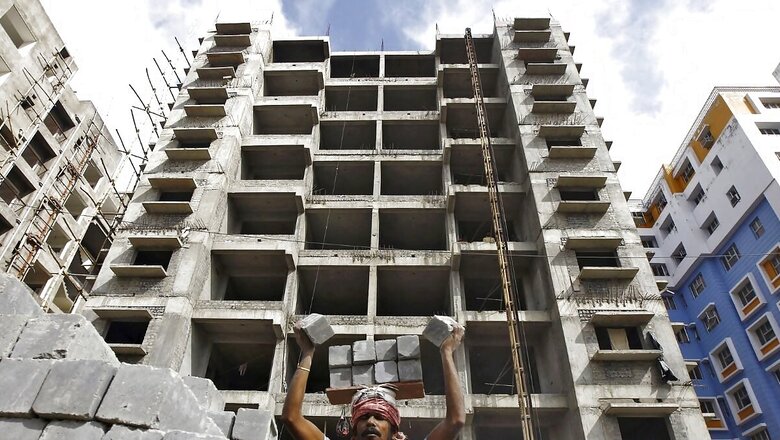
views
Amid a burgeoning housing economy and the central government’s massive and sustained infrastructure push, India is witnessing a construction boom. Owing to this, the country is set to become the third-largest construction market globally following China and the US by 2025, said union minister for housing and urban affairs Hardeep Singh Puri.
Among the fastest growing industries, the construction sector accounts for 9 percent of India’s gross domestic product (GDP). It is the second-largest employer in the country with around 71 million people.
According to Puri, the industry is seen as a central pillar for economic growth by the Narendra Modi-led government. As a result, the construction sector is experiencing rapid growth, serving as a significant indicator of substantive economic progress.
In fact, the sector has only just picked up since the Covid pandemic temporarily paralysed it and is, therefore, expected to surprise with glowing growth numbers in the years to come. Estimates show that the industry is set to reach $1.4 trillion by 2025. In the July-September quarter, it grew by a whopping 13.3 percent year-on-year, marking its best performance in the last five quarters. In 2023, it experienced a real-term expansion of 9.6 percent, surpassing estimated forecasts.
This growth can be attributed to increasing incomes among many Indians, a significant housing shortage in major cities, population growth, and robust government expenditure on infrastructure development.
A construction boom For the ages
The United Nations forecasts that India’s population will reach 1.64 billion by 2047, with approximately 51 percent expected to reside in urban areas. Hence, the Centre has been boosting the construction sector through record-high infrastructure spending, ushering in a construction boom for the ages.
The construction industry in India comprises two main segments — real estate and urban development. Within the real estate segment, there are residential, office, retail, hotel, and leisure park projects among others. The urban development segment encompasses sub-sectors, including water supply, sanitation, urban transport, schools, and healthcare facilities.
Puri further said the government’s heightened attention to the urban sector, noting an elevenfold increase in expenditure on central schemes compared to the roughly Rs 1.7 trillion spent from 2004 to 2014. The outlay for infrastructure spending in the annual budget has multiplied over the years.
In the 2024-2025 budget announcement, finance minister Nirmala Sitharaman announced an allocation of Rs 11.11 lakh crore ($134 billion) for infrastructure development worth 3.4 percent of the GDP. This was up from Rs 10 lakh crore assigned in 2023-24.
This industry is also one of the leading recipients of foreign direct investment (FDI), occupying the sixth place overall and having pulled in more than $32 billion since 2000. The FDI permitted via the automatic route is 100 percent in completed projects for township, mall, and business operations as well as management. The same rule applies to urban infrastructure projects like transport, water supply, sewerage, and sewage treatment.
Robust real estate and cement industries
Heavy cash outlay aside, the sector is further driven by robust real estate and an enviable position in cement and steel manufacturing. The real estate sector is a vital component of the Indian economy, with an estimated market size of $1 trillion by 2030. By 2047, it is projected that the real estate sector will grow to $5.8 trillion, accounting for 15.5 percent of the total economic output.
It boasts of connections with over 250 ancillary industries and providing employment for more than 18 percent of the workforce. Second only to agriculture, real estate stands as one of the largest employment generators. Over the past two decades, its expansion has had a significant ripple effect on the economy. Residential, commercial and retail properties are the primary asset classes driving sectoral growth.
The cement industry has successfully adopted global technological advancements, significantly improving efficiency, conserving energy and fuel, and addressing environmental issues. This industry is the second largest in the world only after China and plays a pivotal role in the economic growth trajectory. It has facilitated India’s growing demands for housing and heightened infrastructure development.
Cement production in India is expected to rise by approximately 12 percent annually, driven by demand for rural housing and government infrastructure initiatives like PM Gatishakti. The industry plans to increase its capacity by about 80 million tonnes by 2025.
Propellers of success
Since 2014, the government’s emphasis on infrastructure development has been a driving force behind India’s economic growth, which has gained significant momentum. Following a visionary approach, the government has played a strong hand in economic growth. The push for affordable housing under the PM Awas Yojana is a key propeller of heightened construction activity, having facilitated the building of nearly 37 million rural households so far.
Megaprojects like GIFT city in Gujarat, the Dholera SIR and the Surat DREAM city are indicators of the infrastructure boom. Projects like the Delhi-Mumbai industrial corridor and the Bengaluru-Mumbai economic corridor add heft to this sector. Heavy investments in the renewable energy sector are also propelling this growth.
The recent announcements of numerous infrastructure projects spanning across states from Jammu and Kashmir to Uttar Pradesh and Tamil Nadu indicates the government’s commitment to ongoing infrastructure development. Given this focus, infrastructure-related stocks and funds are also making strong performances.
The substantial growth in the construction sector has been a key driver of economic growth, and is expected to maintain this role in the coming years. This long-awaited surge has generated millions of jobs and will continue at breakneck pace as the economy takes off.
















Comments
0 comment